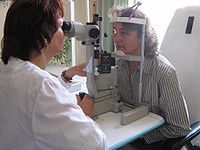
Photo from wikipedia
Background Automated diagnosis of various retinal diseases based on fundus images can serve as an important clinical decision aid for curing vision loss. However, developing such an automated diagnostic solution… Click to show full abstract
Background Automated diagnosis of various retinal diseases based on fundus images can serve as an important clinical decision aid for curing vision loss. However, developing such an automated diagnostic solution is challenged by the characteristics of lesion area in 2D fundus images, such as morphology irregularity, imaging angle, and insufficient data. Methods To overcome those challenges, we propose a novel deep learning model named MyopiaDETR to detect the lesion area of normal myopia (NM), high myopia (HM) and pathological myopia (PM) using 2D fundus images provided by the iChallenge-PM dataset. To solve the challenge of morphology irregularity, we present a novel attentional FPN architecture and generate multi-scale feature maps to a traditional Detection Transformer (DETR) for detecting irregular lesion more accurate. Then, we choose the DETR structure to view the lesion from the perspective of set prediction and capture better global information. Several data augmentation methods are used on the iChallenge-PM dataset to solve the challenge of insufficient data. Results The experimental results demonstrate that our model achieves excellent localization and classification performance on the iChallenge-PM dataset, reaching AP50 of 86.32%. Conclusion Our model is effective to detect lesion areas in 2D fundus images. The model not only achieves a significant improvement in capturing small objects, but also a significant improvement in convergence speed during training.
Journal Title: Frontiers in Neuroscience
Year Published: 2023
Link to full text (if available)
Share on Social Media: Sign Up to like & get
recommendations!